Related Research Articles

The Meruliaceae are a family of fungi in the order Polyporales. According to a 2008 estimate, the family contains 47 genera and 420 species. As of April 2018, Index Fungorum accepts 645 species in the family.

The Phanerochaetaceae are a family of mostly crust fungi in the order Polyporales.
Amethicium is a fungal genus in the family Phanerochaetaceae. A monotypic genus, it contains the single species Amethicium rimosum, a crust fungus first reported from Tanzania in 1983. Amethicium is primarily characterized by its purple fruit body and a dimitic hyphal system. The felt-like tissue layer covering the substrate comprises a thin layer of densely intertwined skeletal hyphae.
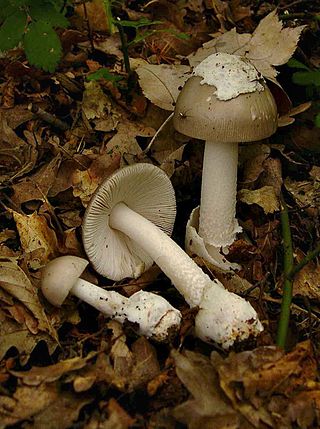
Amanita vaginata, commonly known as the grisette or the grisette amanita, is an edible mushroom in the fungus family Amanitaceae. The cap is gray or brownish, 5 to 10 centimetres in diameter, and has furrows around the edge that duplicate the gill pattern underneath. Unlike many other Amanita mushrooms, A. vaginata lacks a ring on the stem.

Hydnophlebia is a genus of five species of toothed crust fungi in the family Meruliaceae. All species are wood-decay fungi that cause a white rot.
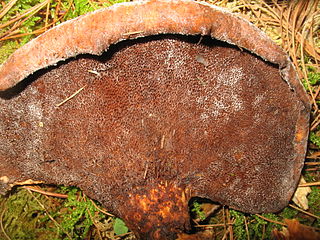
Echinochaete is a genus of fungi in the family Polyporaceae. Circumscribed by English mycologist Derek Reid in 1963, the genus is widespread in tropical regions and contains five species.

Skeletocutis is a genus of about 40 species of poroid fungi in the family Polyporaceae. The genus has a cosmopolitan distribution, although most species are found in the Northern Hemisphere. It causes a white rot in a diverse array of woody substrates, and the fruit bodies grow as a crust on the surface of the decaying wood. Sometimes the edges of the crust are turned outward to form rudimentary bracket-like caps.
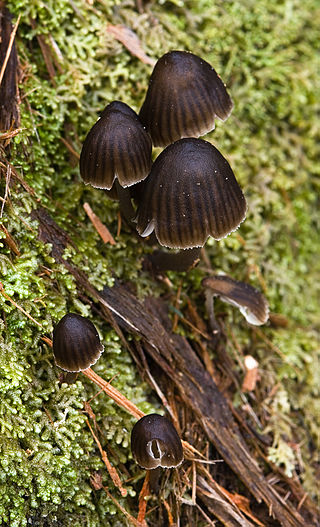
Mycena nargan, commonly known as the Nargan's bonnet, is a species of fungus in the family Mycenaceae, and the sole member of the section Nargan in the genus Mycena. Reported as a new species in 1995, it is known predominantly from Southern Australia. The saprobic fungus produces mushrooms that grow on well-decayed wood, often on the underside of wood lying in litter. The dark chestnut-coloured caps are covered with white, easily removed scales, and reach diameters of up to 2 cm (0.8 in) wide. The pale, slender stems are up to 5 cm (2.0 in) long and have white scales at the base. On the underside of the cap, the cream-coloured gills are widely spaced and bluntly attached to the stem. The edibility of the mushroom is unknown.
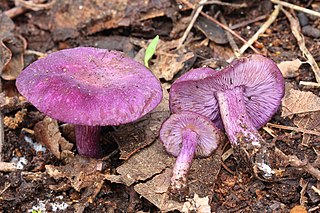
Tricholosporum tropicale is a species of fungus in the family Tricholomataceae. It is found in Mexico.
Skeletocutis africana is a species of poroid crust fungus in the family Polyporaceae. Described as new to science in 2006 by mycologists Leif Ryvarden and Peter Roberts, the fungus is found in Cameroon, where it grows on logs in tropical lowland rainforest environments. The type collection was made in Korup National Park, in South West Province.
Skeletocutis alutacea is a species of poroid fungus in the family Polyporaceae. It was described as new to science in 1946 by American mycologist Josiah Lincoln Lowe as Poria alutacea. Jean Keller transferred it to the genus Skeletocutis in 1979. It is found in the United States and Canada, in Europe, and New Zealand, where it causes a white rot in various woody substrates.
Skeletocutis bambusicola is a species of poroid crust fungus in the family Polyporaceae. It was described as new to science in 2012 by mycologists Li-Wei Zhou and Wen-Min Qin. It is found in southern China, where it grows on dead bamboo. The type collection was made in Mengla County, Yunnan Province. The specific epithet bambusicola refers to its growth on bamboo. At the time of publication, S. bambusicola was the 22nd Skeletocutis species recorded from China.
Skeletocutis borealis is a rare species of poroid fungus in the family Polyporaceae. Found in northern Europe, it was described as new to science in 1998 by Finnish mycologist Tuomo Niemelä.
Globuliciopsis is a genus of corticioid fungi in the order Polyporales. It currently contains two species found in Central and South America.
Atraporiella is a monotypic fungal genus in the family Steccherinaceae. It contains the crust fungus Atraporiella neotropica, known only from Belize.
Skeletocutis subvulgaris is a species of poroid, white rot fungus in the family Polyporaceae. Found in China, it was described as a new species in 1998 by mycologist Yu-Chen Dai. It was named for its resemblance to Skeletocutis vulgaris. The type collection was made in Hongqi District, Jilin Province, where it was found growing on the rotting wood of Korean pine.

Loweomyces fractipes is a species of poroid fungus in the family Steccherinaceae, and the type species of the genus Loweomyces. It is a widely distributed species, found in North America, Europe, Central America, South America, and Korea.

Tyromyces pulcherrimus, commonly known as the strawberry bracket, is a species of poroid fungus in the family Polyporaceae. It is readily recognisable by its reddish fruit bodies with pores on the cap underside. The fungus is found natively in Australia and New Zealand, where it causes a white rot in living and dead logs of southern beech and eucalyptus. In southern Brazil, it is an introduced species that is associated with imported eucalypts.
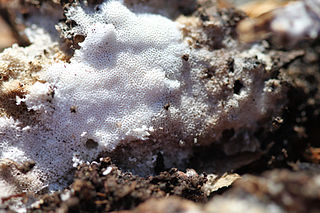
The Gelatoporiaceae are a small family of crust fungi in the order Polyporales. The family was circumscribed in 2017 by mycologists Otto Miettinen, Alfredo Justo and David Hibbett to contain the type genus Gelatoporia and three other related genera, Cinereomyces, Obba, and Sebipora.
Butyrea is a genus of two species of crust fungi in the family Steccherinaceae.
References
- ↑ "GSD Species Synonymy: Skeletocutis azorica (D.A. Reid) Jülich". Species Fungorum. CAB International. Retrieved 2016-09-28.
- ↑ Dennis, R.W.G.; Reid, D.A.; Spooner, B.M. (1977). "The fungi of the Azores". Kew Bulletin. 32 (1): 85–136. doi:10.2307/4117263. JSTOR 4117263.
- ↑ Jülich, W. (1982). "Notes on some Basidiomycetes (Aphyllophorales and Heterobasidiomycetes)". Persoonia. 11 (4): 421–428.
- 1 2 Ryvarden, Leif; Melo, Ireneia (2014). Poroid Fungi of Europe. Synopsis Fungorum. Vol. 31. Oslo, Norway: Fungiflora. p. 141. ISBN 978-8290724462.